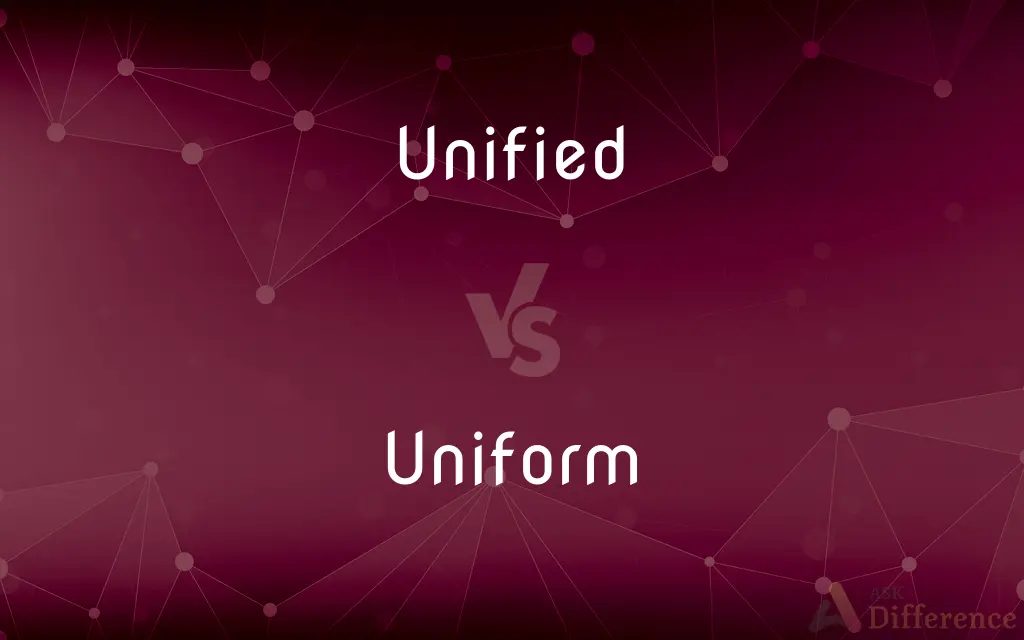Unified vs. Uniform — What's the Difference?
By Urooj Arif & Maham Liaqat — Updated on March 14, 2024
Unified refers to bringing separate elements together to form a cohesive whole, emphasizing harmony and cooperation. Uniform, however, denotes consistency or sameness across all parts, highlighting standardization and lack of variation.

Difference Between Unified and Uniform
Table of Contents
ADVERTISEMENT
Key Differences
Unified describes the process or state of making or being made into a single entity by bringing together diverse components, focusing on integration and collaboration among different elements to achieve a common goal or purpose. It’s about harmony and collective strength, where the individual parts maintain their uniqueness within a cohesive whole. Uniform, on the other hand, is about ensuring that every part or member of a group is the same in appearance, nature, or character, often through imposed standards or rules, to achieve consistency and predictability across the board.
While a unified group works together towards a common objective, respecting and utilizing the diverse qualities and contributions of its members, a uniform group looks and behaves identically, minimizing differences to project cohesion and alignment. This distinction is crucial in contexts like team dynamics, where unified efforts can leverage individual strengths, whereas uniform approaches might suppress individuality for the sake of coherence.
In education, a unified curriculum might integrate various subjects in a cross-disciplinary approach to provide a holistic learning experience, while a uniform curriculum strictly adheres to the same standards and content across all classrooms, ensuring all students receive the same education. This reflects the broader application of both concepts: unified systems value integration and cooperation among diverse components, whereas uniform systems prioritize standardization and consistency.
Organizations strive to be unified in their mission and values, encouraging teamwork and shared objectives among diverse employees, whereas they might implement uniform policies or dress codes to streamline operations and present a consistent image. The choice between fostering unity and enforcing uniformity depends on the goals and values of the organization, as well as the context in which these principles are applied.
Being unified allows for flexibility and adaptation, benefiting from the diverse strengths and perspectives of its components, while being uniform emphasizes predictability, control, and simplicity, potentially at the expense of diversity and creativity. Both concepts play vital roles in various social, organizational, and systemic contexts, depending on the desired outcomes and the nature of the elements involved.
ADVERTISEMENT
Comparison Chart
Definition
Bringing together separate elements to form a whole.
Ensuring sameness or consistency across parts.
Focus
Harmony, cooperation, and integration.
Standardization, consistency, and lack of variation.
Key Characteristics
Collaboration among diverse components.
Sameness in appearance, nature, or character.
Goals
Achieve common objectives while valuing diversity.
Streamline operations and project cohesion.
Application
Team dynamics, integrated systems, holistic approaches.
Policies, dress codes, standardized processes.
Benefits
Flexibility, adaptation, and collective strength.
Predictability, control, and simplicity.
Potential Drawbacks
Complexity in coordination and decision-making.
Suppression of individuality and potential creativity.
Examples
A unified strategy across different departments.
A uniform dress code for all employees.
Compare with Definitions
Unified
Combining diverse elements into a cohesive whole.
The team's unified effort led to a successful project completion.
Uniform
Consistency and sameness across all parts.
The company's uniform branding ensures recognition worldwide.
Unified
Emphasizing harmony and cooperation.
The unified curriculum integrates science and art to enhance learning.
Uniform
Prioritizes control and simplicity.
Uniform guidelines facilitate a streamlined process for approvals.
Unified
Achieves common goals with diverse contributions.
The organization's unified mission fosters a strong sense of purpose.
Uniform
Minimizes differences for alignment.
The franchise's uniform procedures guarantee a consistent customer experience.
Unified
Focuses on integration and shared objectives.
The unified command structure improved efficiency in emergency responses.
Uniform
Enforces standards to achieve cohesion.
The uniform policy aims to eliminate dress code disputes.
Unified
Maintains individuality within a collective.
The coalition remains unified despite the varied interests of its members.
Uniform
Highlights lack of variation for predictability.
The school's uniform curriculum standardizes education quality.
Unified
To make into or become a unit; consolidate.
Uniform
A uniform is a type of clothing worn by members of an organization while participating in that organization's activity. Modern uniforms are most often worn by armed forces and paramilitary organizations such as police, emergency services, security guards, in some workplaces and schools and by inmates in prisons.
Unified
Simple past tense and past participle of unify
Uniform
Always the same, as in character or degree; unvarying
Planks of uniform length.
Unified
United into a whole
Uniform
Being the same as or consonant with another or others
Rows of uniform brick houses.
Unified
That operates as a single entity
Uniform
A distinctive set of clothing intended to identify the members of a specific group
A police uniform.
Unified
That serves all grade levels between kindergarten and twelfth grade.
Uniform
To make (something) uniform.
Unified
Formed or united into a whole
Uniform
To provide or dress with a uniform.
Unified
Operating as a unit;
A unified utility system
A coordinated program
Uniform
Unvarying; all the same.
Uniform
Consistent; conforming to one standard.
Uniform
(mathematics) with speed of convergence not depending on choice of function argument; as in uniform continuity, uniform convergence
Uniform
Composed of a single macromolecular species.
Uniform
(geometry) (of a polyhedron) That is isogonal and whose faces are regular polygons; (of an n-dimensional (n>3) polytope) that is isogonal and whose bounding (n-1)-dimensional facets are uniform polytopes.
Uniform
A distinctive outfit that serves to identify members of a group.
Uniform
(international standards) nodot=1 NATO/ICAO Phonetic Alphabet.}}
Uniform
(police) A uniformed police officer (as opposed to a detective).
Uniform
(transitive) To clothe in a uniform.
Uniform
Having always the same form, manner, or degree; not varying or variable; unchanging; consistent; equable; homogenous; as, the dress of the Asiatics has been uniform from early ages; the temperature is uniform; a stratum of uniform clay.
Uniform
Of the same form with others; agreeing with each other; conforming to one rule or mode; consonant.
The only doubt is . . . how far churches are bound to be uniform in their ceremonies.
Uniform
A dress of a particular style or fashion worn by persons in the same service or order by means of which they have a distinctive appearance; as, the uniform of the artillery, of the police, of the Freemasons, etc.
There are many things which, a soldier will do in his plain clothes which he scorns to do in his uniform.
Uniform
To clothe with a uniform; as, to uniform a company of soldiers.
Uniform
To make conformable.
Uniform
Clothing of distinctive design worn by members of a particular group as a means of identification
Uniform
Provide with uniforms;
The guards were uniformed
Uniform
Always the same; showing a single form or character in all occurrences;
A street of uniform tall white buildings
Uniform
The same throughout in structure or composition;
Bituminous coal is often treated as a consistent and homogeneous product
Uniform
Not differentiated
Uniform
Evenly spaced;
At regular (or uniform) intervals
Common Curiosities
Why might an organization adopt uniform policies?
An organization might adopt uniform policies to streamline operations, ensure consistency, and present a cohesive image.
How do unified efforts benefit an organization?
Unified efforts leverage the strengths and diversity of members to achieve common goals, enhancing flexibility and collective strength.
Can a team be both unified and uniform?
Yes, a team can be both unified in its goals and values and uniform in certain practices or standards, balancing coherence with diversity.
How can a leader foster unity without enforcing uniformity?
A leader can foster unity by valuing diverse perspectives, encouraging collaboration, and focusing on shared goals, without imposing unnecessary uniform standards.
What does it mean to be unified?
Being unified means coming together to form a cohesive whole, emphasizing cooperation and harmony among diverse elements.
What is the difference between a unified strategy and a uniform strategy?
A unified strategy integrates diverse approaches towards a common goal, while a uniform strategy applies the same approach across all scenarios.
What is the significance of uniformity?
Uniformity signifies the consistency and sameness across parts, focusing on standardization and minimizing variation.
Is a uniform approach more efficient than a unified approach?
While a uniform approach can simplify processes and enhance predictability, it may not always be more efficient than a unified approach that benefits from adaptability and diverse inputs.
How does uniformity affect individuality?
Uniformity can suppress individuality by prioritizing sameness and consistency over personal expression and creativity.
In what context is uniformity more desirable than unity?
Uniformity may be more desirable in contexts requiring high levels of control, predictability, and simplicity, such as in safety protocols or branding.
Share Your Discovery

Previous Comparison
Review vs. Confirm
Next Comparison
Gru vs. KgbAuthor Spotlight
Written by
Urooj ArifUrooj is a skilled content writer at Ask Difference, known for her exceptional ability to simplify complex topics into engaging and informative content. With a passion for research and a flair for clear, concise writing, she consistently delivers articles that resonate with our diverse audience.
Co-written by
Maham Liaqat















































